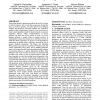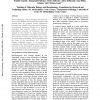135 search results - page 3 / 27 » Optimal control problem on insect pest populations |
GECCO
2007
Springer
13 years 11 months ago
2007
Springer
When facing dynamic optimization problems the goal is no longer to find the extrema, but to track their progression through the space as closely as possible. Over these kind of ov...
JBI
2011
13 years 10 days ago
2011
We are developing a set of ontologies that deal with vector-borne diseases and the arthropod vectors that transmit them. For practical reasons (application priorities), we initiat...
GECCO
2006
Springer
13 years 9 months ago
2006
Springer
In this paper, we propose the island model parallel memetic algorithm with diversity-based dynamic adaptive strategy (PMADLS) for controlling the local search frequency and demons...
GECCO
2005
Springer
13 years 11 months ago
2005
Springer
In neuroevolution, a genetic algorithm is used to evolve a neural network to perform a particular task. The standard approach is to evolve a population over a number of generation...
GECCO
2005
Springer
13 years 11 months ago
2005
Springer
In this work we provide empirical evidence that shows how a variable-length genetic algorithm (GA) can naturally evolve shorter average size populations. This reduction in chromos...


